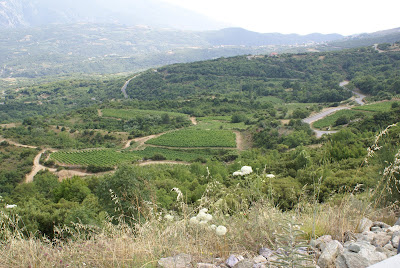 The best produce road in the region, perhaps in America, this time of year is the 20-mile stretch of Route 896 between Russellville, where 896 and Route 10 intersect at a four-way stop, and Strasburg, Pennsylvania, on the outskirts of Lancaster. This is uncommercialized Amish and Mennonite country, and the first-time traveler will be fascinated by the large farms that have no electric lines leading to the houses and barns, by horse-drawn farm instruments lumbering through the fields and hay meadows, and by roadside signs in hot weather that read "water for horses." And horses do travel this road constantly, pulling small carriages of one to four people going from one farm to the next or to commercial shops on the Strasburg Road.
The best produce road in the region, perhaps in America, this time of year is the 20-mile stretch of Route 896 between Russellville, where 896 and Route 10 intersect at a four-way stop, and Strasburg, Pennsylvania, on the outskirts of Lancaster. This is uncommercialized Amish and Mennonite country, and the first-time traveler will be fascinated by the large farms that have no electric lines leading to the houses and barns, by horse-drawn farm instruments lumbering through the fields and hay meadows, and by roadside signs in hot weather that read "water for horses." And horses do travel this road constantly, pulling small carriages of one to four people going from one farm to the next or to commercial shops on the Strasburg Road.This is farming country with huge, rolling fields of corn and tobacco - still a large local crop, witness the number of tobacco barns with their strips of siding that open to let the bundled leaves dry after harvesting - as well as vegetable gardens for fresh food for the table in the summer and canned produce for the rough winters. And as a summer cash crop to sell to tourists or locals passing through.
Last week, we drove to Lancaster to do some outlet shopping as well as buy fresh produce for the weekend. It seemed that every quarter mile there was another small farm stand, often manned by young girls in long, traditional skirts or young boys with straw hats and black trousers held up by braces. For foodies, the signs shouted out temptations: Fresh blackberries, corn, tomatoes by the bushels, locally made root beer, brown, free-range hen eggs, onions, squashes, cucumbers, melons and old-fashioned flowers for the table.
We limited ourselves to juicy blackberries to make a cobbler, tomatoes for pasta sauce and gazpacho, and some root beer for a hot afternoon.
The next day, I felt like getting in the car and doing it all again.
Stopping for a fresh milkshake. Another locavoracious favorite is Woodside Farm Creamery in North Star, near Hockessin, in Delaware. How many places can you stop for fresh ice cream and see the brown and white cows - Guernseys, if my childhood memories serve me right - that produced it grazing in the field above the ice cream stand?
I stopped by the other day for a milkshake, and the shop was like a scene from Norman Rockwell. Perhaps a dozen children were running about outside while their minders lolled around picnic tables under the shade trees. As I was trying to decide my flavor, the kids were running in asking for samples of bacon ice cream served by the young women behind the counter on bite-sized plastic spoons.
Clearly, the combination of bits of real bacon blended into ice cream was too much for some of the young explorers. One young lad got a disgusted look on his face and ran out when his bite was offered. I was not tempted either. I left drinking a cookies-and-cream.
Until next time...













